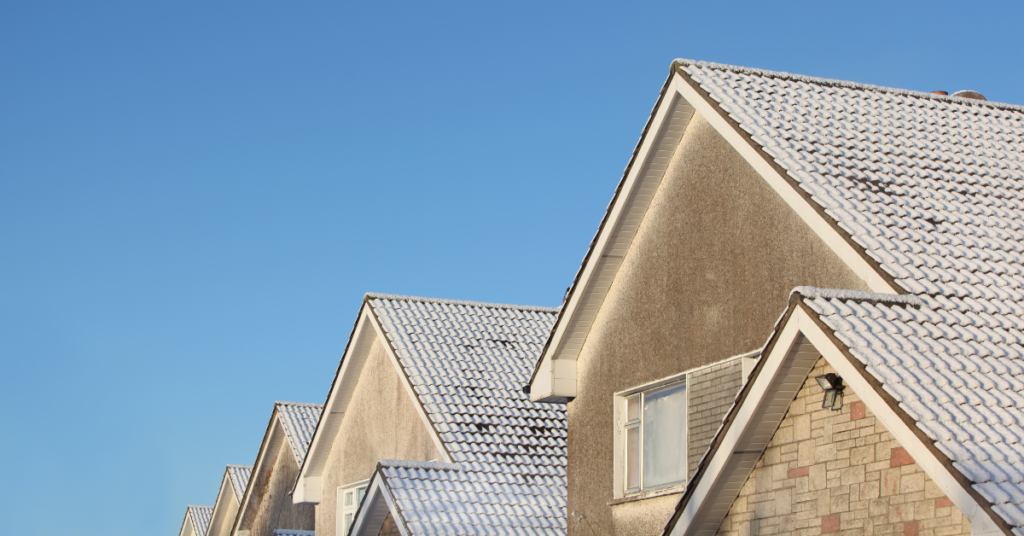Top Roof Winterization Tips for the Willamette Valley

At Stutzman & Kropf, we know that the Willamette Valley’s winters can be particularly challenging for homeowners. With the combination of cold temperatures, heavy rainfall, and occasional snow, taking steps to winterize your roof is crucial to protect your home and avoid costly repairs. Here are our top tips to help you prepare your roof for the winter season and ensure it stands strong against Oregon’s weather.
1. Inspect and Repair Roof Damage Early
One of the most effective ways to prepare your roof for winter is to inspect it thoroughly before the cold weather hits. Look for any signs of damage, such as:
- Missing or cracked shingles: These can allow water to seep into the roof structure, causing leaks and potential rot.
- Damaged flashing around chimneys or vents: Ensuring that flashing is intact prevents water from entering through vulnerable areas.
- Sagging or soft spots: These might indicate structural issues that need immediate attention.
Repairing these small issues early can save you from larger, more expensive problems once the winter storms begin. If you’re not comfortable inspecting your roof yourself, consider scheduling a professional inspection. At Stutzman & Kropf, we offer thorough roof inspections to ensure your home is ready for the season ahead.
2. Clean and Maintain Gutters
Clogged gutters are one of the most common sources of winter roof damage. When gutters are filled with leaves and debris, water can’t flow properly, which can lead to ice dams or water backing up under the shingles. This can cause leaks and damage to both your roof and home exterior.
Here’s how you can prepare your gutters:
- Clear debris: Use a ladder and gloves to remove leaves, twigs, and other blockages.
- Check downspouts: Make sure downspouts are clear and direct water away from your foundation.
- Install gutter guards: If you want to minimize maintenance, consider adding guards that prevent debris buildup while allowing water to flow freely.
Routine gutter maintenance not only protects your roof but also keeps your home safe from potential water damage throughout the winter.
3. Remove Moss, Debris, and Overhanging Branches
The Willamette Valley’s damp climate is ideal for moss growth on roofs. While it might not seem like a big issue, moss can trap moisture, leading to rot and shingle damage. Additionally, leaves and other debris can accumulate, further contributing to moisture buildup.
Here are some steps to take:
- Sweep or rinse off moss and debris: Use a broom or gentle hose spray to clear moss and leaves, but avoid pressure washing as it can damage shingles.
- Apply moss treatment: Products designed for roof moss control can help prevent regrowth, but make sure to choose eco-friendly options that won’t harm your garden or local waterways.
- Trim overhanging branches: Remove branches that could fall during storms or shed leaves and debris onto your roof.
By keeping your roof clean and clear of moss and debris, you’ll help extend its lifespan and keep it protected through the winter months.
4. Ensure Proper Attic Ventilation and Insulation
A well-ventilated and insulated attic plays a crucial role in winterizing your roof. Proper ventilation allows warm, moist air to escape, preventing condensation that could lead to mold and rot. It also helps regulate temperature, reducing the risk of ice dams forming along your roof’s edges.
To make sure your attic is prepared:
- Check attic vents: Ensure that vents are not blocked by insulation or debris, allowing air to flow freely.
- Inspect insulation levels: Proper insulation helps keep heat inside your home, reducing your energy bills while maintaining a consistent roof temperature. This is key to preventing ice dams, as it stops warm air from melting snow on the roof and refreezing at the eaves.
- Look for signs of moisture: If you notice any damp spots or mold, it could indicate inadequate ventilation or insulation that needs to be addressed.
Taking care of your attic’s ventilation and insulation helps protect not only your roof but also your entire home from moisture-related damage during winter.
5. Schedule a Professional Roof Inspection
Even with careful DIY efforts, it’s a good idea to schedule a professional inspection before winter hits. Roofing experts like our team at Stutzman & Kropf can spot issues that might not be visible from the ground or to the untrained eye. Professional inspections cover critical areas, including:
- Flashing around chimneys and vents
- Gutter integrity and drainage
- Signs of structural stress or water damage
By catching potential problems early, you’ll have peace of mind knowing your roof is prepared to handle the upcoming season’s challenges. Plus, having a trusted professional inspect your roof annually ensures your roof remains in optimal condition year-round.
Prepare Your Roof for Winter Success
Winterizing your roof is essential for every homeowner in the Willamette Valley. From inspecting for damage to maintaining gutters and ensuring proper attic ventilation, these proactive steps help protect your home from the region’s wet and cold winters.
If you’re ready to get your roof in shape for winter, or if you want a professional eye to ensure everything is set, contact Stutzman & Kropf. We’re here to help with everything from inspections to maintenance, so you can enjoy a warm and worry-free winter season.
#
This article was originally published on StutzmanandKropf.com. For all of your Oregon roofing needs, give us a call today.
